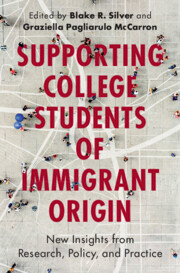Book contents
- Supporting College Students of Immigrant Origin
- Supporting College Students of Immigrant Origin
- Copyright page
- Dedication
- Contents
- Figures
- Tables
- Contributors
- Foreword
- Part I Beginnings
- Chapter 1 Understanding College Students of Immigrant Origin
- Chapter 2 The College Enrollment Process for Students of Immigrant Origin
- Chapter 3 Multilingual Adolescent Mentors and Tailored College Knowledge for Immigrant Students
- Chapter 4 The Role of Family Histories in Students of Immigrant Origin’s Aspirations and College Decision-making Process
- Chapter 5 Complicating College Readiness for Students of Immigrant Origin
- Part II Experiences
- Part III Institutional Arrangements
- Part IV Looking Forward
- Epilogue
- Index
- References
Chapter 4 - The Role of Family Histories in Students of Immigrant Origin’s Aspirations and College Decision-making Process
from Part I - Beginnings
Published online by Cambridge University Press: 16 May 2024
- Supporting College Students of Immigrant Origin
- Supporting College Students of Immigrant Origin
- Copyright page
- Dedication
- Contents
- Figures
- Tables
- Contributors
- Foreword
- Part I Beginnings
- Chapter 1 Understanding College Students of Immigrant Origin
- Chapter 2 The College Enrollment Process for Students of Immigrant Origin
- Chapter 3 Multilingual Adolescent Mentors and Tailored College Knowledge for Immigrant Students
- Chapter 4 The Role of Family Histories in Students of Immigrant Origin’s Aspirations and College Decision-making Process
- Chapter 5 Complicating College Readiness for Students of Immigrant Origin
- Part II Experiences
- Part III Institutional Arrangements
- Part IV Looking Forward
- Epilogue
- Index
- References
Summary
Drawing upon interview data from a yearlong study with fourteen children of Latinx immigrants applying to college, I explore how students’ visions of their futures shape their college decision-making processes. I utilize possible selves theory as a guiding framework, which speaks to how people imagine who they may become in the future and can guide their actions (Markus & Nurius, 1986). I explore the following research questions: (1) how do children of Latinx immigrants conceive of their possible futures, both within higher education and beyond?, (2) what is the connection between student and familial pasts in the conceptualization of educational futures, and (3) how do students’ conceptualizations of the future shape their higher education decision-making? What I find is that students think about various possible versions of themselves simultaneously in their decision-making. This chapter contributes to current research on college choice/decision-making, the application of possible selves theory to postsecondary education, and increased insight on the role of immigrant origins in the construction of higher education aspirations among the children of Latinx immigrants.
Keywords
- Type
- Chapter
- Information
- Supporting College Students of Immigrant OriginNew Insights from Research, Policy, and Practice, pp. 64 - 86Publisher: Cambridge University PressPrint publication year: 2024

